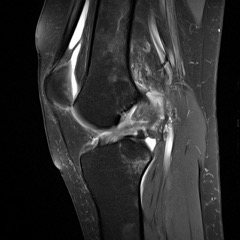Can a torn ACL actually grow back??!?
Case History
A 44-year-old lady presented having injured her left knee skiing 1 week before. There was the fairly typical history of a twisting injury to the knee with a ‘crack’ in the joint, followed by the knee then giving way, with the knee then feeling very wobbly and unstable afterwards.
When I examined the patient’s knee, there was no specific tenderness and there was no significant swelling evident. The knee had reasonably good movement, and the anterior drawer test felt negative. However, an MRI scan showed what appeared to be a total (or possibly subtotal) tear of the ACL.
As per my usual practice, I referred the patient across to one of our excellent local physiotherapists to start some rehab / ? prehab ? treatments… and I advised the patient to give things time and to see how things went, in terms of just how stable or unstable her knee might end up feeling once she had plateaued in her recovery… which would then determine whether or not she might end up needing a surgical ACL reconstruction.
An update from the patient’s physio 4 months later stated that the patient was making good progress, with no episodes of instability.
Just recently, the patient got in touch with me again. It is now 2 years since the patient’s knee injury, and she reported that her knee still felt stable. She was going to the gym regularly, doing Pilates and doing yoga, all without any issues. However, the patient wanted some advice as to whether or not she should go skiing again…
The clinical examination knee showed a ‘happy’ knee, with no tenderness, no effusion, a full and pain-free range of motion, no signs of any meniscal issues, and a nice sold stable joint, with, still, a negative anterior drawer test.
An up-to-date MRI scan (2 years after the ACL injury) showed amazingly good healing of the ACL, with no signs of any damage to any of the other structures in the knee.
The patient had a full, detailed, functional return-to-play assessment with her physiotherapist, and this showed that her functional tests revealed a roughly 5% deficit on the left side (the injured side). The left quads strength was just 4% lower than the right side, but the hamstring strength was still down by 17%.
Thankfully, and sensibly, the patient stated that she probably wasn’t going to go skiing again this season, and that she would probably look at going next season instead (in a year’s time). I therefore simply advised the patient to continue with her strength and fitness work, but to focus specifically on building up as much strength as she possibly could in her left hamstrings, to protect her ACL.
So, great news for the patient (in that she was able to avoid the pain, hassle, risks, costs and rehab associated with a surgical ACL reconstruction)… but what can we learn from this case?
Does this lady’s imaging mean that a torn ACL can grow back??!?…
Easier answer: NO!
What this case actually demonstrates very nicely is the following:
1) You can never fully trust or entirely rely solely on just an MRI.
MRI pictures can be misleading, with false positives as well as false negatives, even for something that one would assume should be fairly clear-cut and obvious, like an ACL tear.
Remember, an MRI image is not a photo: it is simply a 2D representation of the % water content at any specific pixel location. So, if an ACL is damaged and if it is swollen and bloody, then it will look widened, pale and irregular, with loss of the normal striations that are seen with a normal ligament with intact fibres. This lady’s case is by no means the first time that I’ve seen what appears to be a complete ACL rupture, where the injury actually turns out to be just a partial tear.
With a complete rupture the torn ligament ends normally ‘ping’ apart and the stumps retract and scar up, and it is physically impossible for a new ligament to simply grow back and for the two ends to reattach, and for the ligament to then miraculously re-tension itself. However, with a partial tear, if a decent % of the fibres of the ligament are still in-continuity, there can be significant propensity for healing.
2) With a patient with a suspected ACL tear, if their anterior drawer test doesn’t feel significantly positive, and if the patient isn’t actually reporting any particular feelings of instability, then a cautiously conservative approach, based on intensive physio rehab + appropriate time, is normally the correct treatment, because with this approach many patients do well, which means that they might end up with a ‘good enough’ knee without the pain, risks, costs, hassle and rehab time that are needed with a surgical ligament reconstruction.
3) And finally… this lady’s case also highlights the importance of the patient seeing the best possible physiotherapist, for the best possible treatment and guidance, and it also highlights the importance of patients undertaking a full, proper, detailed functional ACL return-to-play assessment ahead of them potentially going back to any high-risk activities that involve pivoting / twisting through the knee.
And to finish with…
A big thank you to my lovely patient, who kindly gave permission for her story and her pictures to be shared. And thank you, also, to the team at APPI Physio & Pilates, in Wimbledon, for providing such excellent expert care to my patients.


